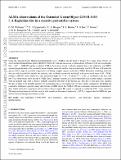Files in this item
ALMA observations of the Extended Green Object G19.01-0.03 I. A Keplerian disc in a massive protostellar system
Item metadata
| dc.contributor.author | Williams, Gwenllian M. | |
| dc.contributor.author | Cyganowski, Claudia J. | |
| dc.contributor.author | Brogan, Crystal L. | |
| dc.contributor.author | Hunter, Todd R. | |
| dc.contributor.author | Ilee, John D. | |
| dc.contributor.author | Nazari, Pooneh | |
| dc.contributor.author | Kruijssen, J. M. Diederik | |
| dc.contributor.author | Smith, Rowan J. | |
| dc.contributor.author | Bonnell, Ian A. | |
| dc.date.accessioned | 2021-10-15T10:30:13Z | |
| dc.date.available | 2021-10-15T10:30:13Z | |
| dc.date.issued | 2022-01 | |
| dc.identifier | 276294257 | |
| dc.identifier | 69470000-fbf6-4d45-8414-b833e2a131bb | |
| dc.identifier | 85121234102 | |
| dc.identifier | 000741326000051 | |
| dc.identifier.citation | Williams , G M , Cyganowski , C J , Brogan , C L , Hunter , T R , Ilee , J D , Nazari , P , Kruijssen , J M D , Smith , R J & Bonnell , I A 2022 , ' ALMA observations of the Extended Green Object G19.01-0.03 I. A Keplerian disc in a massive protostellar system ' , Monthly Notices of the Royal Astronomical Society , vol. 509 , no. 1 , pp. 748–762 . https://doi.org/10.1093/mnras/stab2973 | en |
| dc.identifier.issn | 0035-8711 | |
| dc.identifier.other | ArXiv: http://arxiv.org/abs/2110.06262v1 | |
| dc.identifier.uri | https://hdl.handle.net/10023/24146 | |
| dc.description | G.M.W. acknowledges support from the Uk's Science and Technology Facilities Council (STFC) under ST/R000905/1 and ST/M001296/1. C.J.C acknowledges support from the UK's STFC under ST/M001296/1 and J.D.I. acknowledges support from the UK's STFC under ST/T000287/1. J.M.D.K gratefully acknowledges funding from the Deutsche Forschungsgemeinschaft (DFG, German Research Foundation) through an Emmy Noether Research Group (grant number KR4801/1-1 and the DFG Schbeihilfe (grant number KR4801/2-1 as well as from the European Research Council (ERC) under the European Enion's Horizon 2020 Research and Innovation programme via the ERC starting grant MUSTANG (grant agreement number 714907) | en |
| dc.description.abstract | Using the Atacama Large Millimetre/submillimeter Array (ALMA) and the Karl G. Jansky Very Large Array (VLA), we observed the Extended Green Object (EGO) G19.01-0.03 with sub-arcsecond resolution from 1.05 mm to 5.01 cm wavelengths. Our 0.4'' ∼ 1600 AU angular resolution ALMA observations reveal a velocity gradient across the millimetre core MM1, oriented perpendicular to the previously known bipolar molecular outflow, that is consistently traced by 20 lines of 8 molecular species with a range of excitation temperatures, including complex organic molecules (COMs). Kinematic modelling shows the data are well described by models that include a disc in Keplerian rotation and infall, with an enclosed mass of 40-70M⊙ (within a 2000 AU outer radius) for a disc inclination angle of i = 40°, of which 5.4-7.2 M⊙ is attributed to the disc. Our new VLA observations show that the 6.7 GHz Class II methanol masers associated with MM1 form a partial ellipse, consistent with an inclined ring, with a velocity gradient consistent with that of the thermal gas. The disc-to-star mass ratio suggests the disc is likely to be unstable and may be fragmenting into as-yet-undetected low mass stellar companions. Modelling the centimetre--millimetre spectral energy distribution of MM1 shows the ALMA 1.05 mm continuum emission is dominated by dust, whilst a free-free component, interpreted as a hypercompact HII region, is required to explain the VLA ∼ 5 cm emission. The high enclosed mass derived for a source with a moderate bolometric luminosity (∼104 L⊙) suggests that the MM1 disc may feed an unresolved high-mass binary system. | |
| dc.format.extent | 2043904 | |
| dc.language.iso | eng | |
| dc.relation.ispartof | Monthly Notices of the Royal Astronomical Society | en |
| dc.subject | Stars: individual: G19.01-0.03 | en |
| dc.subject | Stars: formation | en |
| dc.subject | Stars: massive | en |
| dc.subject | Stars: protostars | en |
| dc.subject | Masers | en |
| dc.subject | Techniques: interferometric | en |
| dc.subject | QB Astronomy | en |
| dc.subject | QC Physics | en |
| dc.subject | NDAS | en |
| dc.subject.lcc | QB | en |
| dc.subject.lcc | QC | en |
| dc.title | ALMA observations of the Extended Green Object G19.01-0.03 I. A Keplerian disc in a massive protostellar system | en |
| dc.type | Journal article | en |
| dc.contributor.sponsor | Science & Technology Facilities Council | en |
| dc.contributor.institution | University of St Andrews. School of Physics and Astronomy | en |
| dc.contributor.institution | University of St Andrews. Sir James Mackenzie Institute for Early Diagnosis | en |
| dc.identifier.doi | 10.1093/mnras/stab2973 | |
| dc.description.status | Peer reviewed | en |
| dc.identifier.grantnumber | ST/M001296/1 | en |
This item appears in the following Collection(s)
Items in the St Andrews Research Repository are protected by copyright, with all rights reserved, unless otherwise indicated.

